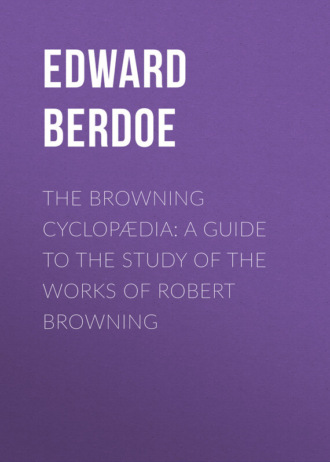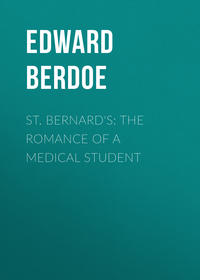 полная версия
полная версияThe Browning Cyclopædia: A Guide to the Study of the Works of Robert Browning
Note. – Verse ii., Gibson, John (1790-1866), the sculptor, best known to fame by his “Tinted Venus.” He died at Rome. Verse iii., Grisi, Giulietta (born in Milan, 1812), one of the most distinguished singers of our time She came to London in 1834, and at once took a leading position in the operatic world. Verse xv., bals-parés == dress-balls.
APPENDIX
Epistle Of Karshish. Dr. R. Garnett published the following note on this poem in the Academy of 10th October, 1896: —
“British Museum,“16th Sept., 1896.“Browning, in his ‘Epistle of Karshish,’ commits an oversight, as it seems to me, in making Lazarus fifty years of age at the eve of the siege of Jerusalem, circa 68 A.D. The miracle of which he was the subject is supposed to have been wrought about 33 A.D. He would consequently have been only about fifteen at the time, which is quite inconsistent with the general tenor of the narrative. According to tradition, Lazarus was thirty at the time, and lived thirty years longer, not surviving, therefore, to the date intimated in Browning’s poem.
‘A black lynx snarled and pricked a tufted ear.’If I do not mistake, there is no such thing as a black lynx, except as a lusus naturae. It is easy to see how the generally accurate Browning fell into this error. The Syrian lynx, which he is describing, has black tufted ears – the whole outer surface of the ear is black – and the Turkish name by which it is commonly known, cara-cal, means ‘black ear.’ Browning, intent on the creature’s special characteristic, has extended the blackness from the ear to the entire body.”
Pietro of Abano. Verse 10.
“Alphabet on a Man’s Eyes“In Alonzo Lee, of Atlanta, Galveston, the Americans have found a singular phenomenon, nothing less than the alphabet marked quite plainly on the edge of the iris of each of his eyes similar to the figures on a watch. This wonder is said to have been caused by his mother, who was an illiterate woman, desiring to educate herself. In each eye the entire alphabet is plainly marked in capital letters, not, however, in regular order. The ‘W’ is in the lower part of the iris and ‘X’ at the top. They appear to be made if white fibre wove cord, being connected at the top by another cord seemingly linked to the upper extremity of each letter. The eye itself is blue, with white lines radiating from the centre almost to the letters themselves: these letters do not slope exactly in the direction that the radials extend from the centre. Beginning at the bottom with ‘W’ and following the letters like the hands of a watch they can be more readily distinguished. So too, the irregularity is a striking feature, showing how the mother learned her letters in broken patches, as a child learns when beginning to read. Lee, who has been three times divorced, has a son whose eyes are similar to his father’s.”
Echo, 23rd March, 1896.The Ring and the Book. Book I., l. 902. “Caritellas,” evidently for “carretellas.” “A kind of drosky with a single pony harnessed to the near side of the pole.” See The Romance of Isabel, Lady Burton, vol. ii., p. 538.
Book I. “O Lyric Love,” etc. The following letter was sent to me as likely to be interesting on account of Mr. Browning’s own explanation of his terms Whiteness and Wanness. My correspondent says: “I happen to have an original letter from R. Browning in which he says, ‘The greater and lesser lights indicate the greater and less proximity of the person,’” etc. Wanness should be taken as meaning simply less bright than absolute whiteness, as Keats speaks of “wannish fire,” etc.
Book VIII., l. 329. The torture referred to by De Archangelis as the Vigiliarum, is evidently identical with that called the “Vigilia” and which is described in Hare’s Walks in Rome. “Upon a high joint-stool, the seat about a span large, and, instead of being flat, cut in the form of pointed diamonds, the victim was seated; the legs were fastened together and without support; the hands bound behind the back, and with a running knot attached to a cord descending from the ceiling; the body was loosely attached to the back of the chair, cut also into angular points. A wretch stood near pushing the victim from side to side; and now and then, by pulling the rope from the ceiling, gave the arms most painful jerks. In this horrible position the sufferer remained forty hours, the assistants being changed every fifth hour.
Book IX., l. 1109. “The sole joke of Thucydides.” Mr. F. C. Snow, writing from Oxford to the Daily News, says: “Browning was misled by a scholiast. The ancient critics said, ‘Here the lion laughs,’ with reference to the passage of Thucydides where the story of Cylon is told (l. 126, see also the Scholia). But they did not mean that the passage contained any joke, only that the narrative style was unusually genial. There are other passages of Thucydides where his grim humour comes much nearer to the modern idea of pleasantry.”
“The lion, lo, hath laughed!” in the context, proves the correctness of Mr. Snow’s explanation.
Sordello. Book III., l. 975. In the Athenæum, 12th December, 1896, Mr. Alfred Forman published a letter on this passage which is an important contribution to our commentary on Sordello.
“In a review of Dr. Berdoe’s Browning Cyclopædia, I have seen it asked: ‘In what form did Empedocles put up with Ætna for a stimulant?’ In what form indeed! But I think a more pertinent question would have been: How can either Empedocles or, as is usually alleged, Landor have anything to do with the passage referred to? To me it has always appeared to be Æschylus whom Browning (vol. i, pp. 169-70, of the seventeen-volume edition, 1888-94, Smith, Elder & Co.) addresses as
‘Yours, my patron-friend,Whose great verse blares unintermittent onLike your own trumpeter at Marathon, —You who, Platæa and Salamis being scant,Put up with Ætna for a stimulant.I need not recall the legend of the Greek tragedian having fought at Marathon as well as at Salamis and Platæa (the ‘stimulants’ to his ‘Persæ’), but his ancient biographer further says: ‘Having arrived in Sicily, as Hiero was then engaged in founding the city of Ætna, he exhibited his “Women of Ætna” by way of predicting a prosperous life to those who contributed to colonise the city.’ After a perusal of pp. 52-53, we may imagine that Æschylus was one of Browning’s audience (‘few living, many dead’), and not unlikely, as coming from the realm where Browning says he had ‘many lovers’ (p. 53), to be designated a ‘patron-friend,’ while the ‘great verse’ that ‘blares unintermittent on,’ etc., is surely identical (pp. 53-4) with
‘The thunder-phrase of the Athenian, grownUp out of memories of Marathon.“I have not been able to discover any substantiating facts in the life, or passages in the works, of Landor; but possibly some correspondent of yours may be able to lay me under an obligation by pointing such out. A simple statement to the effect that ‘Browning said so’ could not, I think, in such a case as the one in question, be deemed satisfactory. Dr. Garnett writes to me on the matter as follows: —
“‘Could the poet alluded to in Sordello possibly be R. H. Horne? Horne was, I think, an intimate friend of Browning’s; he was more Æschylean than any other contemporary; he had served as soldier and sailor in the Mexican War; and, having given up arms for letters, might be said to have forsaken Marathon and Salamis for Ætna, although the introduction of Ætna would be quite incomprehensible but for the historical fact of Æschylus’s secession thither. I do not feel convinced that the identification of Horne with Browning’s “patron-friend” is the correct interpretation, but it seems to me to deserve attention.’
“While on the subject of Sordello, may I ask how (as I have seen it assumed in ‘Browning’ books) the ‘child barefoot and rosy’ of p. 288 can be Sordello himself? In the first place, are not the words he is singing taken from Sordello’s own ‘Goito lay’ (cf. pp. 97, 249, 289), with which he vanquished Eglamor, long after he had ceased to be, if he ever was, a rosy and barefoot child? And, in the second place, is there any indication in the whole poem that Sordello was ever ‘by sparkling Asolo,’ where the aforesaid child is described as being?
“Alfred Forman.”Book VI., l. 614: —
“The old fable of the two eagles.” They —“Went two waysAbout the world: where, in the midst, they met,Though on a shifting waste of sand, men setJove’s temple.”The story is referred to in Pindar’s “Fourth Pythian Ode,” where he speaks of “Jove’s golden eagles.” These were placed near the Delphic tripod, and probably gave rise to the story of the two birds sent by Jupiter, one from the east and the other from the west, and which met at Pytho or Delphi. Mr. Browning seems to be in error here. Delphi was not “on a shifting waste of sand,” but on a mountain; and the temple was not that of Jove, but of Apollo. The poet appears to have sent the eagles to the oasis of Ammon, which was in the middle of a sandy desert and had a most famous oracle of Zeus.
1
Out of print at present.
2
Out of print at present.
3
Out of print at present.
4
Out of print at present.
5
Out of print at present.
6
Out of print at present.
7
Out of print at present.
8
Out of print at present.
9
Out of print at present.
10
Out of print at present.
11
Out of print at present.
12
One of the most remarkable instances of the use made of antithesis I ever heard was at Friern Barnet Church, into the porch of which I strolled when walking one summer day some twenty-five years ago. I was just in time to hear the preacher use words which I have never forgotten. The antithesis of the sentence was perfect:
“If thou wouldst hereafter be where Christ is, see thou be not found now where He is not, lest when He come he say to you, what now by your conduct you say to Him ‘Depart from Me – where I am you cannot come!’” If any one would investigate this principle of antithetic reading further, let him take Macaulay’s “Essay on Von Ranke’s Popes,” vol. ii., p. 128, and beginning at the words, “There is not, and there never was,” see how to place the correct emphasis by observation of the opposed ideas. This is the one great secret of good reading. Printers’ punctuation is horribly misleading, and should usually be disregarded.
13
See Browning Society’s Papers, Pt. XII., p. 81.
14
This is a mistake: it should be Ongar, not Norwich.
15
The name Druses is generally, but not universally, believed to be derived from this Darazi. – E. B.
16
By means of riddles, as related in the Bible.
17
The above sonnet, by Robert Browning, is copied from The Monthly Repository (edited by W. J. Fox) for 1834, New series, vol. viii., p. 712.
18
For the above suggestions I am indebted to the Notes of the Browning Society, Part VII., p. 42*.
19
Browning stopped his work on Sordello to write Strafford.
20
Compare this use of the Light metaphor with Browning’s frequent use of it in his poems, as I explain in the article on “Browning as a Scientific Poet” in my Browning’s Message to his Time.




